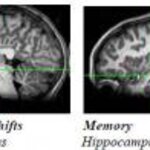Neuroscience

As teenagers' drive for peer approval begins to eclipse their family affiliations, things change in their brains - literally. Brain scans of teens sizing each other up reveal an emotion circuit activating more in girls as they grow older - but not in boys.
So that urban legend about girls maturing faster than boys is true, if by faster maturity we mean becoming overly emotional drama queens.
A new study says emotion circuitry diverges in the male and female brain during a developmental stage in which girls are at increased risk for developing mood and anxiety disorders.
"…

If you have a 'difficult' baby, don't worry too much about your parenting skills. A new report in Psychological Science says that a child's temperament may be due in part to a combination of a certain gene and a specific pattern of brain activity.
The pattern of brain activity in the frontal cortex of the brain has been associated with various types of temperament in children. For example, infants who have more activity in the left frontal cortex are characterized as temperamentally "easy" and can be soothed with less effort. Conversely, infants with greater activity in the right half…

The American Chemical Society (ACS) has announced plans to launch a new journal devoted to the molecular aspects of neurological science in both health and disease. The bimonthly journal will be peer-reviewed, online-only publication without charges for publication and color figures.
ACS Chemical Neuroscience will launch in January 2010 with Craig W. Lindsley, Ph.D., of Vanderbilt University School of Medicine, as Editor-in-Chief. Topics expected include nerve activators and receptors; nerve growth and development; nerve imaging; pain and sensory processing; and the diagnosis…

The front portion of the brain that handles tasks like decision-making, the left inferior frontal sulcus, also helps decipher different phonetic sounds, according to new Brown University research. This section of the brain treats different pronunciations of the same speech sound (such as a 'd' sound) the same way, they say, and in determining this they believe they have solved a mystery.
"No two pronunciations of the same speech sound are exactly alike. Listeners have to figure out whether these two different pronunciations are the same speech sound such as a 'd' or two different sounds…

A team of researchers from the University of Alcalá de Henares (UAH) says that human beings can develop echolocation, the system of acoustic signals used by dolphins and bats to explore their surroundings. Producing certain kinds of tongue clicks helps people to identify objects around them without needing to see them, obviously something that would be useful for the blind, if it's true.
The team has started a series of tests, the first of their kind in the world, they say, to make use of human beings' under-exploited echolocation skills.
Much cooler than Man-Bat. ©Marvel Comics Group…

In an article published in the June 25th edition of the journal Neuron, researchers at the Hotchkiss Brain Institute, University of Calgary, have found that synaptic plasticity, long implicated as a device for ‘change’ in the brain, may also be essential for stability.
Homeostasis, the body’s own mechanism of regulating and maintaining internal balance in the body, is necessary for survival. Precisely how the brain pulls off this tricky balancing act has not been well appreciated.
By examining neural circuits that regulate fluid volume, Jaideep Bains, PhD, and colleagues, Brent Kuzmiski, PhD…

Clinical scientists at the Hotchkiss Brain Institute are starting the first pilot study looking at the delivery of insulin via the nasal passageway as a potential new treatment for diabetic neuropathy (DPN).
About 50 per cent of people with diabetes will develop DPN, a debilitating and painful nerve disease. Current treatment is limited to pain management only.
Cory Toth, MD, fellow, Lawrence Korngut, MD, and colleagues, have demonstrated that intransal insulin helps protect nerves in the brain and central nervous sysem (cns) of mice. It also slowed the progression of …

We do lots of things without thinking about it, like driving to work while we talk on the phone. We have a kind of 'autopilot' that kicks in for things we have practiced and it allows us to do other things simultaneously.
For people with schizophrenia it's a little different. Dutch researcher Tamar van Raalten investigated whether a disruption to the automation process, learning by repetition to do something on automatic pilot, explains why people with schizophrenia can process less information. She established that it is not the automation process but the processing of new information…

Autistics are up to 40 percent faster at problem-solving than non-autistics, according to a new Université de Montréal and Harvard University study published in Human Brain Mapping. As part of the investigation, participants were asked to complete patterns in the Raven's Standard Progressive Matrices (RSPM) test that measures hypothesis-testing, problem-solving and learning skills.
While autism is a common neurodevelopmental disability characterized by profound differences in information processing and analysis, this study showed that autistics have efficient reasoning abilities that…

Injury of the peripheral nerves, such as the nerves in your arms, is common and often results in a loss of function or sensation. Although these nerves have the capacity to regenerate and reconnect, recovery is often limited to short distances and outcomes remain relatively poor.
There are surgical procedures that have been developed but they are highly invasive and full functional recovery is not guaranteed. That is why researchers at the Hotchkiss Brain Institute at UCalgary conducted a study to explore a novel potential treatment for chronic nerve injury. The…